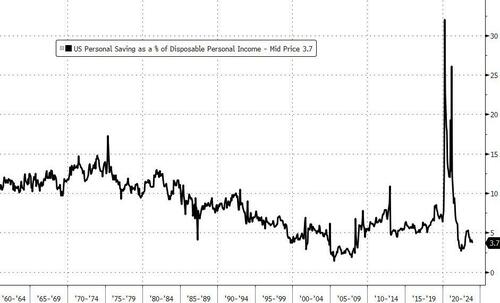It seems that many consumers are convinced the Fed will soon drastically drop interest rates and it will be a big boost to the economy. To many younger people, decades of lower interest rates are the only thing they have ever known. The problem here is that lower rates do not necessarily lead to a stronger economy.
Part of the problem is that we are seeing the best of this data being revised downward month after month. This news is generally not highlighted on the front page but buried where it is less noticed. What could go wrong in a system where the President has been declared so mentally impaired that he cannot be held responsible for handling documents related to our security and safety?
While Americans seem unable to stop spending, signs are rising that we are reaching the point where lenders would be foolish to extend more credit to them. Today credit card debt is at an all-time high, car repos soaring, commercial real estate is close to crisis mode, and consumer savings rates are very low. All these trends point to trouble ahead.
Adding to these woes is that inflation is
not done, residential housing affordability is terrible while the fed
deficit soars and unfunded debt obligations are creeping up. In some sense, it is pathetic that some investors' bright hopes are centered on history's record of Presidential collection years as being positive for the stock market. This is clouded, of course, by something we have heard a lot about, and been warned about, recency bias.
This is our tendency to overemphasize the importance of recent experiences or the latest information that we have witnessed when estimating future events. Recency bias often takes us in the direction of thinking that recent events are more of an indication of how the future will unfold than they really are. Considering the direction of the stock market for decades, recency bias paves the way to thinking other than a few short-lived pullbacks it is always up, up, and away.
Still, some of the data coming out is concerning. If you take a close look at job creation numbers you will find that as of late an explosion in the number of new jobs being created in the government and its money-funded healthcare sector. This is not good news, a healthy economy needs private sector growth. There is evidence we may soon start to see private sector layoffs soar as companies try to remain profitable when they are forced to refinance debt at higher interest rates.
The Bureau Of Labor Statistics (BLS) birth-death model may be skewing much of the current employment data. Part of this is due to the increased use of Employee Identification Applications also known as EINs. The need to have an EIN is tied to getting a 1099 tax form which in 2000 was dropped from 20,000 dollars to 600 dollars.
This has promoted many new applications for the easy to apply for EIN. However, these are not new businesses or increasing employment simply moving existing commerce into another part of the economy. Here it is important to remember, that many new businesses don't amount to diddly-squat. Most close within a year often leaving behind unpaid bills. Unpaid debts may create jobs but not the productive kind the economy needs.
When trying to get a handle on where the economy is headed, it is also important to consider data showing the personal savings rate has collapsed. Data reports indicate for many people, real income is down. This means many people are living paycheck to paycheck. In short, people do not have discretionary income to save even with a record number of people working more than one job.

Also telling is that the BLS has sharply slashed the number of estimated hours that everyone was working, from 34.3 to just 34.1. This is a big drop. The last time the workweek was this low was when the economy was shut down during covid. Other than the covid lockdowns, we have to 2010 to find such a short workweek. that was this anemic.
Some economy watchers argue we have been in a rolling recession and we are closer to the end of it than the beginning. Still, if we return to the idea the main factors holding up the American economy are growing debt and government spending we have a problem. It does not help that America's yearly trade deficit just came in at a staggering $773.4 billion. The article in this link, spins this a positive development, after all, it is a huge decrease from the prior year.
Other factors feeding into the economic picture are also fogging reality. For example, a boom in the construction of manufacturing plants started in mid-2021. Last year companies plowed an annualized $220 billion into this sector, which is up by 170% from December 2019. This will have long-term ramifications for the economy as does the fact that this surge in construction will not continue forever.
I would like to end this post by circling back to the issue of jobs. An article that appeared on Zerohedge gives us something to ponder. It called the last jobs report the most ridiculous in recent history. Based on the numbers, it claims that all the job creation in the past four years has gone to foreign-born workers, but there has been zero job-creation for native-born workers since July 2018!
In addition, the Zerohedge article points out that while in January the BLS claims 353K payrolls were added, the Household survey found that the number of actually employed workers dropped by 31K. Those of us who believe economic cycles cannot be eliminated only kicked down the road where they wallop even a bigger punch than if allowed to occur see a lot of reasons to question where the economy is headed.
(Republishing this article is permitted with reference to Bruce Wilds/AdvancingTime Blog)


No comments:
Post a Comment